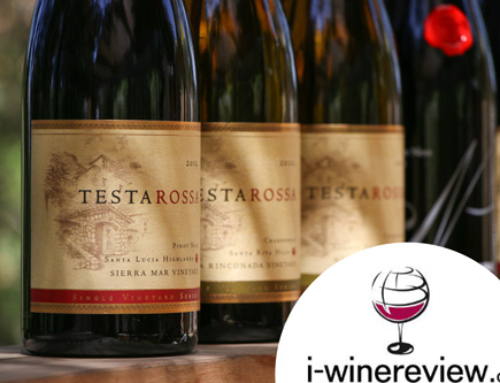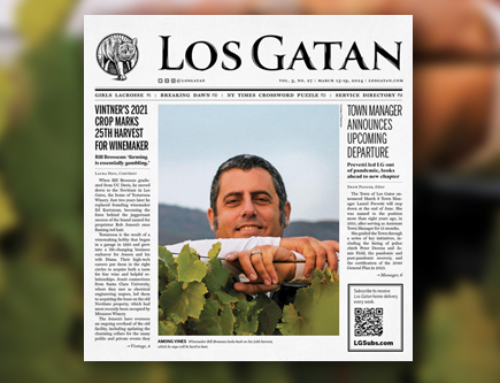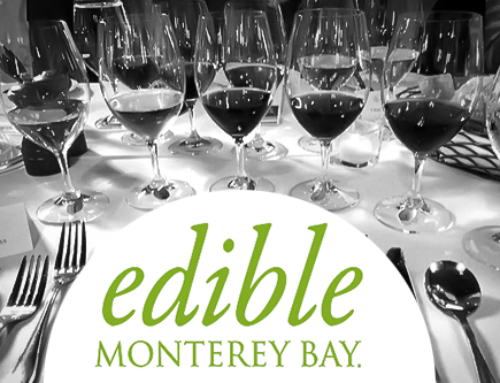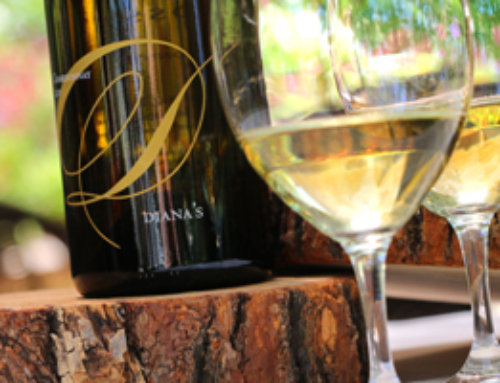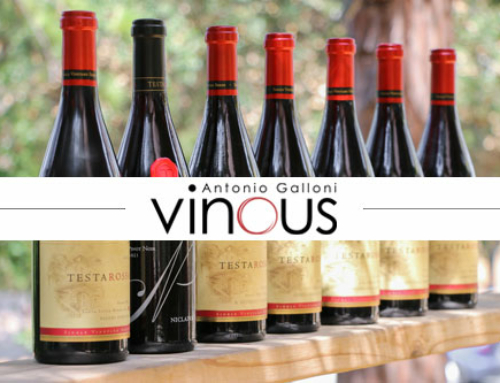by Laura Ness
In front of us loomed 7 large Pinot glasses generously endowed with some of the rarest and most coveted of Pinots in all of California. It is impossible to utter the words “Garys’ Vineyard” without invoking a hush of respect. To have both Garys’, Franscioni and Pisoni, boyhood friends whose fathers went to high school together, sitting on a panel with a well-respected sommelier, Randy Bertao, and arguably one of the consistently best winemakers in the industry, Bill Brosseau, was an equally rare opportunity. It was one slice of delicious and precious time that nobody wanted to rush. In fact, it was almost reverential, except that nothing involving Gary Pisoni could be anything but hilarious, boisterous and filled with endearing anecdotes that have become an indelible part of both the Santa Lucia Highlands legend and its lexicon.
Traveling through a vertical of seven vintages with the growers and winemaker who made these special wines happen was an unparalleled thrill. To taste such a storied lineup side by side, in the presence of those responsible for a good deal of their provenance, was a rare and informative pleasure.
Gary Franscioni explained that the vineyard project that bears their name was first planted in 1997, but their relationship goes back to childhood. They both recall being 3 or 4 years old when theirs were among the 6 families that routinely got together for summer barbecues. Their fathers went to high school together in Gonzales. Gary P noted that he had always wanted a cooler site than his home ranch. Gary F found it, but they were stymied on what to call it until Gary P said, “Heck, we’re both Garys’!!”
Franscioni noted that the partnership was a handshake deal. Pisoni explained the terms: “If we have a disagreement, we go into the cellar and have a bottle of wine. If we can’t agree, we have a second bottle. We have never gotten to that second bottle yet!”
It was Gary Pisoni who was the first of the two to plant, beginning in 1982, when he convinced his father that growing row crops was good, but growing grapes could be so much greater. “Dad, have you ever been to a $250 per person lettuce tasting?” he pleaded. His mother actually gave him the nod. And so, the young just out of college Gary with a suitcase filled with cuttings from various vineyards in Burgundy, sometimes called the “underwear clones,” began what would become the relentless Burgundian invasion of the Santa Lucia Highlands. Says Gary P, “I got lucky! I love Pinot, and I knew Cabernet would not work!” He recently yanked out the last of his underperforming Cabernet: his son Jeff, their winemaker, and son Mark, their vineyard manager, both insisted it had to go.
The Garys’ vineyard is complex within itself, according to Gary F, who says that all the clones are developed from the same vineyard cuttings originally planted by Gary P: “We don’t know what they are. We sell to 30 wineries and maybe three winemakers will come down every month, some more often during harvest. Others only show up once! Bill Brosseau is always introducing experiments to us. I call him crazy! Testarossa pays by the acre, so they can do whatever they want!”
Gary P interjected, “We love Bill! He’s innovative. Gary F is always saying, ‘Uh oh, here comes another crazy experiment!’”
Gary F replied, “The best experiments are the ones we can learn from, even if it’s ‘Let’s not do that again!’ Most lead us to a change in direction, like spraying with Stylit oil instead of sulphur. It’s an All Star Team and we all work well together.”
Added Bill, “Every little micro decision we make in the vineyard has a huge impact. Climate drives aromas. Soil drives the texture. The mixture of loam and rocks gives us a nice balance year in and year out.”
They have put in four vineyards so far together and a fifth is in the works. Says Bill Brosseau of working with the two of them, “Their core values haven’t changed an ounce since I’ve known them for the last 15 years. Their kids (referring to Mark and Jeff Pisoni and Adam Franscioni) are like clones of them. They are dependable and they always continue to get better.”
TASTING THE LINEUP We began with the 2005, dark and mysterious, with sanguine aromas intermingled with basil, earth, chervil and a teasing florality. The flavors are roses, cranberry, pomegranate and green tea, and the complexity and acid get high marks. This wine appears to be 5 to 8 years from its peak.
The 2007 shows off persistent earthy plumminess, accentuated by a smoky note of cherry tobacco and coffee. On the palate, angular flavors of pomegranate, wheat bread, hot breakfast cereal (wheatina comes to mind) and blueberry dominate, with a chocolatey finish. The tannins are still intense, making one long for a pepperoni pizza to pair. This one has a lot of stuffing and will go two decades. This is Gary F’s personal favorite of the lot. Bill remarked that the tannins were indeed massive, and he had to work a lot of magic to tame them, stirring constantly even through malo. “I was really worried this wine would never calm down!”
Next up was the 2009, which has seriously charry aromatics, combined with roasted tomatoes. Intriguing flavors of grilled ham and cheese with peppers lead to a nice, dry, meaty finish. This one can definitely use some more bottle age and a hearty meal.
The 2010 is deep and dark in color, with vibrant aromas of black cherry and licorice, fabulous flavors of juicy dark cherry and a smooth and silky mouthfeel that keeps
you coming back for more. This wine is youthful, vibrant and just coming into its own. Bill remarked that it was nicely balanced, gorgeous with great acid and he expects it may age in a similar fashion to the 2005, although he believes it to be a bit more Burgundian in style. This was a personal favorite of most in the room.
Vintage 2011 reflects the last wet year we’ve had in California. Bill noted that the mildew pressure that year was tremendous. A lot of people were shortcropped and shortchanged. This brilliant, lovely wine has a reserved nose of cranberry, raspberry and red cherry and juicy but not sweet flavors of the same, along with charming strawberry-rhubarb pie, with generous dollops of baking spice. It’s silky, yet taut, with great acidity and keeps on revealing layers of succulent treats, like potpourri, apricot-cranberry chutney and brown sugared walnuts.
The 2013 has pretty and saucy aromas of sarsaparilla, red rosehips, red currant tea and red licorice, and in the mouth, it’s youthfully exuberant, delivering bright raspberry-chocolate toffee with chewy tannins.
The final wine in the vertical was a barrel sample of the 2014 vintage, taken from 5 different barrels. Although the oak totally dominated, you could clearly get the charm of the raspberry, chocolate and cherry aromas, and the juicy, cranberry, blood orange and cherry flavors flowed like a stream with good acid, fleshy tannins and a supple, supremely pleasing texture leading to a fine finish of cranberry scone laden with king spice.
How does Bill choose the best barrels to showcase? Basically, he says he is like a conductor, looking for a soloist for the world stage. The others go into the symphony. All the barrels are pretty close to each other in quality, so he has to dig deep to discern the really star performers.
Bill remarked that his overall goal is to create wines that age gracefully. “My objective is to let the site be distinctive.” He noted with pride that he poured Garys’ Vineyard Pinot at his wedding. “I’m a grape bouncer. We’ve let a lot of other vineyards go because the grapes are not respected. The Garys’ look out for their reputation down the line and it shows.”
Added Gary F, “Mark (Pisoni) goes around to taste the wines other wineries have made each year out of barrel. We’ve asked people to declassify wines that we felt we didn’t want our name on. We also watch the price points others are charging. That’s our name that’s on the label.”
He went on to note that at one point they had 11 acres in this vineyard that were underperforming. “Jeff and I were making wine from there. We just weren’t happy with the flavors. It was not high end wine.” At a cost of $1.5M, they changed the row direction and replanted with Calera and Mount Eden clones. “The beauty of having our sons continuing in this business is that we are all continuing to learn and evolve.”
He also noted that relatively speaking, the Santa Lucia Highlands is pretty new : the association, of which he is now President, is only 9 years old. Compare that to Burgundy, which has a 400 year history. He observed that Garys’ Vineyard, at nearly 20 years old, is really just starting to reveal its essence. “The kids better not screw it up!”
Gary P quipped that he was a psych major in college, much to his Dad’s consternation: “What are you going to do with that?” Well, says, Gary, “I figured I would use it to talk to the grapes. Turns out that I’ve learned how to listen to the grapes! They really do talk to you, and all you have to do is listen.”
Bill echoed this by noting that he has gradually reduced his use of oak, mostly because he wanted to let the vineyard site speak, not the forest. He likened the process to creating music: he’s a drummer, and he knows the harmony is there somewhere. “I’m learning to focus on the metaphysical voices.”
A general observation on this flight is that not only could you taste the common thread of the vineyard, but you could clearly sense the commonality shaped by the hand of the same winemaker as well. Both Garys’ commented on how unusual it was to have the same person at the helm for such a long period of time. They sell to 30 plus different wineries, and few have had the same winemaker over the duration.
Gary P perhaps said it best when he commented, “Bill amplifies the voice of the earth without destroying it.”

